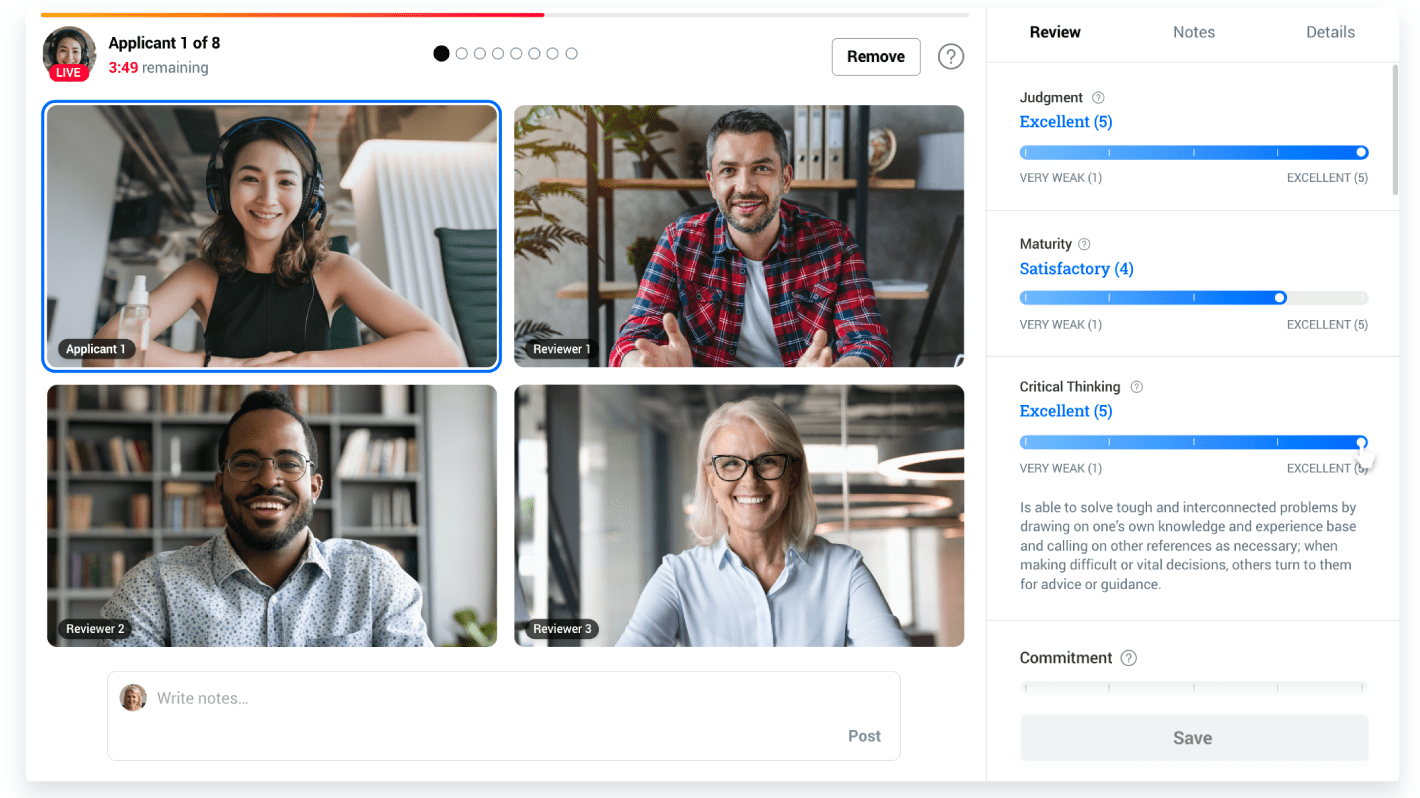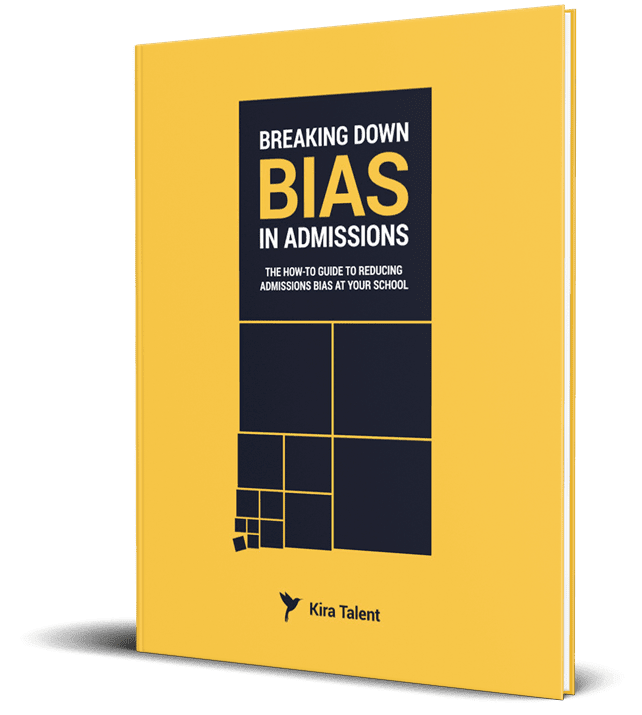Great video is no longer a nice-to-have, it’s a need to have. Your prospective students expect it.
Here, we’ll review the strategies behind some great videos for college admissions to deconstruct why these campaigns work and three key approaches to keep in mind when creating a video that resonates with your audience. (No matter how small or large your budget may be.)
Note: You’ll need audio/video functionality on your device (and headphones if you’re in an open or shared office) for this post.
Let’s get started!
1. Understand Your Audience
As you can imagine, there is no one-size-fits-all solution to make a higher education recruitment video that works. However, the schools that do well have a clear vision of what they are trying to achieve. Before you start designing your campaign, ask yourself the following questions:
- What are your goals?
- Who is it for?
- What is your message?
- How will you know it’s working?
- What else can you do to double your chances of success?
One of the biggest mistakes schools make is saying “I want that” when they see something another school has. Then they just hand it off to an agency without doing proper internal and external research. Look inside at the unique value your school or program has to offer and build a campaign out of what makes you special. You can’t fake or copy authenticity, so don’t even try.
Case Study: Université de Moncton
Université de Moncton (who won the 2015 Kira Award for Best Higher Ed Recruitment Video) went with an approach that wouldn’t get through the approval process in most institutions.
By focusing on what defined them, being a Francophone university in a minority setting in New Brunswick, they crafted a campaign about the uniquely French student experience offered at the school.
The smoldering kiss in the library got people talking, which was exactly the point. In French, “la langue” is the tongue, but it’s also the word for language, making a play on words in the narration.
“Most people will take the safe way,” says Denis Boucher, Director of Recruitment for the University. “Everybody has a great program, everybody has scholarships, if you keep saying that you’re not sticking out. And we wanted to stick out.”
When you try to appeal to everybody, you appeal to nobody. Define your goals and your target audience early and pursue their interests. If you back down and try to please everyone, you risk diluting your message and missing the mark.
Working with an agency, Boucher and his team identified that the Francophone student experience was their strength. They tested the idea on local high school students before launching it as this was the demographic they wanted to impress. Not testing is a dangerous mistake that universities often make with their recruiting efforts, out of either a lack of time or a fear of their “good idea” leaking into the world. Neither are a good excuse to not test.
Another success factor for this ad was its length. According to YouTube, videos that are 30 seconds or less have a 90 percent playback completion rate, compared to a video at one minute with just 59 percent completion.
We see a similar trend across other social networks, with videos and video ads on networks like Facebook, Twitter, and Instagram performing best when short.
To double their chances of success, a fresh website and recruitment brand launched in 2015, focused on making French ‘cool’ to potential students. With a viral video garnering national media attention and hundreds of thousands of YouTube views, the combined recruitment efforts resulted in an increase of 22 percent for domestic applicants.
Your shiny new video doesn’t live in a vacuum, it has to work in tandem with your other marketing efforts, so think carefully about what you can do to boost your chances of success.
“Find out what’s different about your university and ride on that,” recommends Boucher. And of course: “Take some calculated risk.”
2. Tell a Better Story
We love advertisements that make us feel. Whether we laugh or cry, a good story gives us something in exchange for being advertised to, and tomorrow’s students crave that from their favorite brands. As Michael Brenner, Head of Strategy for NewsCred writes on Entrepreneur, “millennials don’t want ads. They want stories.”
A problem with traditional college ads is that they try to appeal to everyone: students, faculty, prospective students, alumni, parents. By watering the message down, many schools often miss telling authentic, engaging stories. College ads are often so boring and predictable that YouTube personality Ryan Higa (@nigahiga), who has over 16 million subscribers, made an entertaining satire of “EveRy University,” out of frustration with the oh-so-typical college ad.
So how do you tell a good story?
You’ve identified your audience, your goals, and the message you want to deliver. Our recommendation?
The most successful recruitment campaigns aim to either inspire or relate.
Inspire
An inspirational story can show the impact your school has on the world or the individuals who attend it. If you can make a video that changes the viewer, makes them feel something new, your brand resonates.
The ads that most-often go viral are like short cinematographic masterpieces that make you feel a whole range of emotions. Perhaps you remember this Thai bank advertisement that amassed millions of YouTube hits across various video uploads? Or the Argentinian organ donation PSA, “The Man and The Dog”?
At the end, you’ve been moved, and that’s the difference.
Western Sydney’s Unlimited Campaign drew international media attention to the university as they shared compelling alumni stories, in particular one of defense lawyer Deng Thiak Adut that has gained over 2.1 million views on YouTube.
By telling the powerful story of an alumnus and showcasing his ability to be a successful lawyer against all odds, Western Sydney gives the audience goosebumps and becomes a memorable school to potential applicants.
Moving away from traditional college value statements and the talking heads of heavily-coached students and faculty members, Western Sydney brings viewers inside the life of this particularly incredible alumnus, inspiring them with the possibilities that come from a Western Sydney degree.
Although less scandalous than University of Moncton, this video was so excellent that it warranted headlines in national news, as well as advertising and business publications, and easily managed to go viral on social media.
Relate
A relatable story makes the education you offer within reach. When viewers can see themselves at your school, they’re one step closer to finding their new home away from home.
As NewsCred identifies, “64 percent of the millennials studied said that they respond more positively to brand messages that are tailored to their cultural interests” and “62 percent felt similarly about messages that are useful and help them solve their unique everyday problems.”
Believing a brand cares about you and understands you is an important qualification for millennial buyers.
Open University and BI Norwegian both take creative approaches to connect to their applicants.
On one hand, Open manages to introduce audiences to realistic, relatable characters in just 60 seconds.
The school effectively identified their target audience (mature, career-minded, busy professionals who are looking to expand their skillsets) and shot a video which speaks directly to their audience’s fears and desires.
Let’s pretend we’re Open University, for the sake of exercise, and apply the initial planning questions to their case:
What are your goals?
Inspire mature career-focused people and show how others like them are getting their education.Who do you want to reach?
Mature, career-focused people in the UK.What is your message?
You can take an OU course while working full-time. It has the power to accelerate your potential.How will you know it’s working?
When applicant volume increases next year, when word of mouth spreads.What else can you do to double your chances of success?
We're going to build a website with the same messaging to double our chances.
The characters are real: they strive, struggle, and celebrate. If you read through the YouTube comments, you see dozens of Open grads testifying that the school had a positive impact on their life, adding the social proof that is especially essential for online programs.
BI Norwegian, jumps on at the opposite end of the spectrum, appealing to their millennial audience by speaking directly to their fears and desires with an admissions contest. “All you have to do is apply” to win this prize-pack of fame, friendship, and fun for your new life in Oslo.
The campaign video tours the city and the school as the narrator explains the prize and contest rules, shaping a true campus community vibe in the mind of the viewer while making the applicant feel special and important. BI Norwegian makes it clear: We know you’re taking a risk moving to Oslo, but you won’t be alone when you get here.
If we were BI Norwegian, here’s how we’d walk through the initial planning questions:
What are your goals?
Educate international students about Oslo, increase international applicant volume, increase brand awareness.Who do you want to reach?
Late 20's social-savvy international students who are curious about travelling abroad but are concerned about moving too far into the unfamiliar.What is your message?
You'll feel right at home in Oslo.How will you know it’s working?
When international applicant volume increases next year, when word of mouth spreads.What else can you do to double your chances of success?
We're going to turn this into a real contest that you can enter. We're going to build a website around this with consistent messaging. We're going to go on a PR blitz to get coverage.
3. Make Video Go Beyond Video
To really hit a home run in today’s mixed media environment, you can’t simply make a video. Television ads seem to only perform well when they’re on the Superbowl, and especially when targeting millennials. As noted in our blog post, "Why Do Students Apply Where They Apply," TV only had a 6 percent reach among prospective MBA students.
The average MBA applicant applies to three or more programs in different cities, according to LinkedIn. It's easy to apply and it's easy to research schools so competition is fierce.
Your school needs to stand out.
With every great recruitment video, comes an equally great integrated campaign.
When Universite de Moncton launched their video campaign, it was part of a larger renewal: they launched a new recruitment-specific website and new brochures that aligned with the new look and feel. They also hired a new recruiter to speak to prospective students.
Western Sydney’s stunning campaign was a set of three videos, promoted on the web and TV, and delivered online through a prospective student-focused microsite with an easy-to-use program-selector quiz.
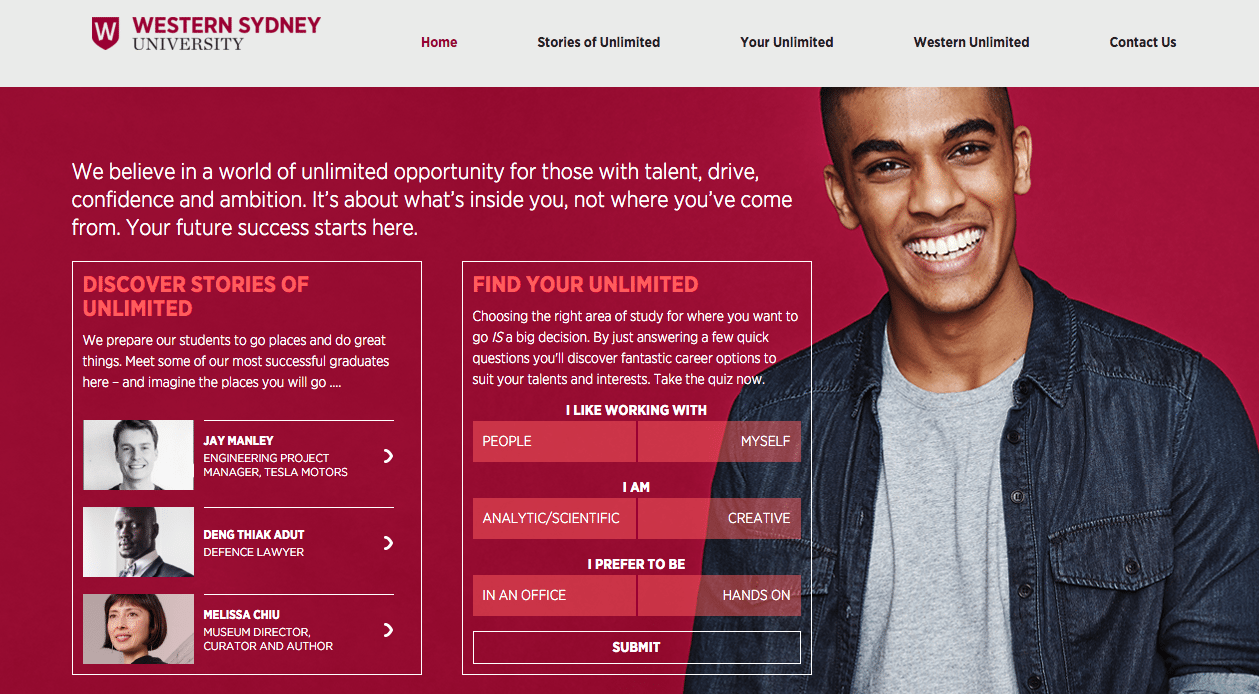
BI Norwegian’s video was the introduction to their contest campaign, directly targeting international students, and their fear of going abroad on their own. “Join the competition” was the clever call-to-action that initiated the admissions process and worked as a brilliant lead generation strategy to gather prospective students’ email addresses.
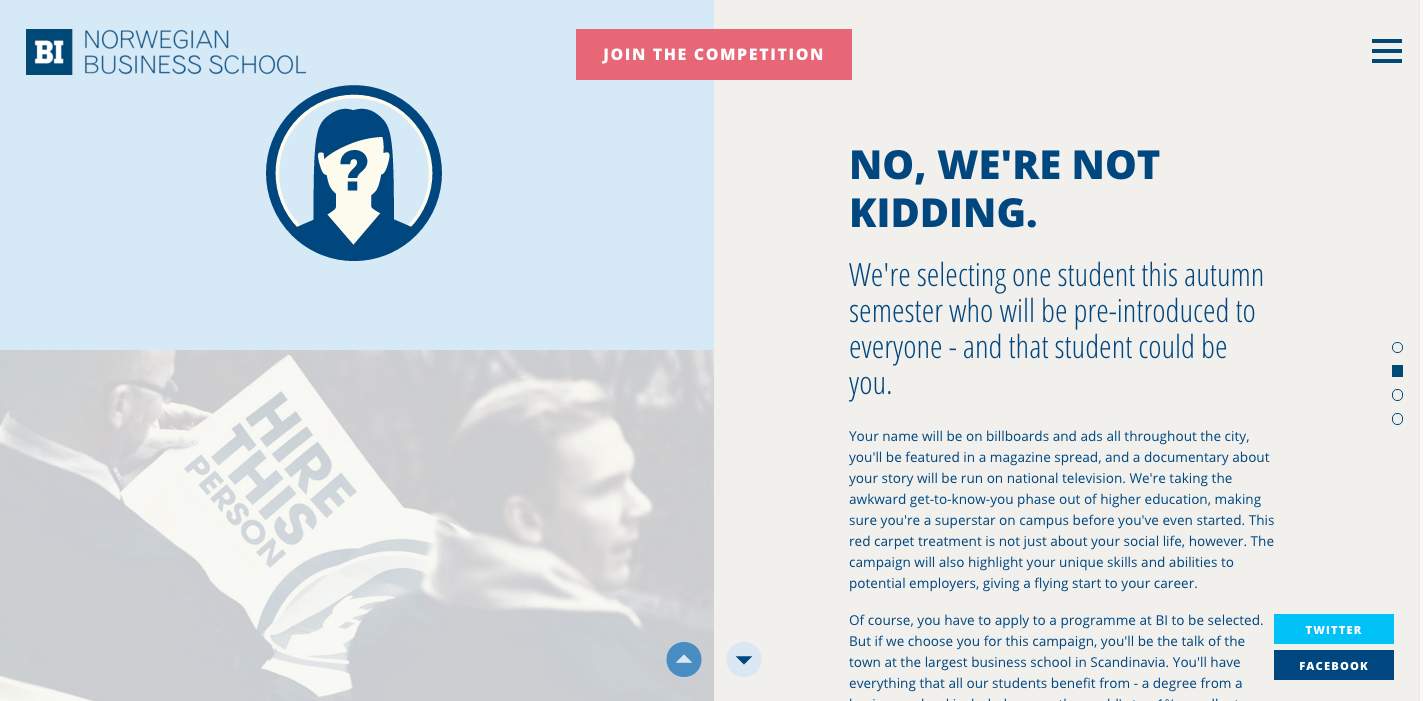
One more excellent example is UBC Sauder School of Business’s The Spirit of Discovery campaign. With fifteen unique stories, six presented through video, Sauder created a content-based campaign loaded with interesting facts, stats, and quotes, packaged in beautiful design.
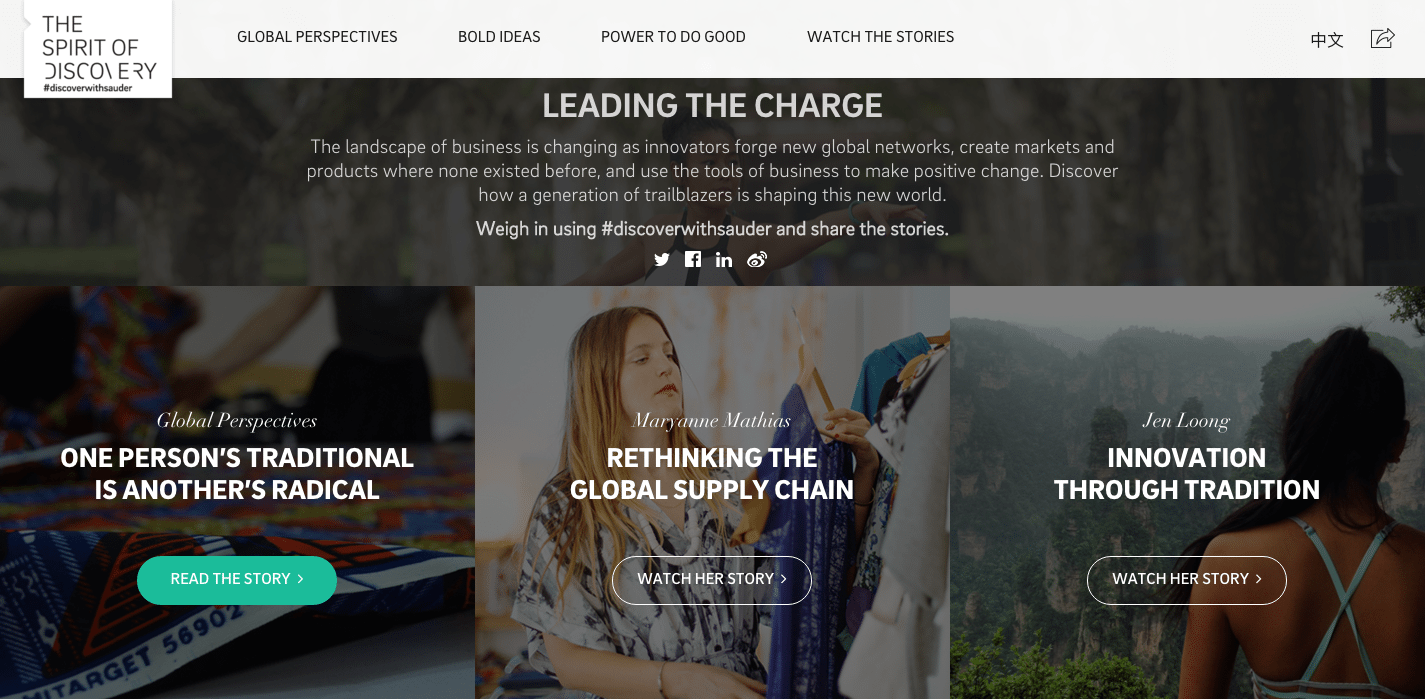
Instead of relying on one video as their flagship campaign piece, Sauder tells multiple stories that appeal to different types of business leaders. Graphic design and well-planned infographics are at the center of this strategy, while video serves as an important accessory to the overall, immersive experience of the campaign.

